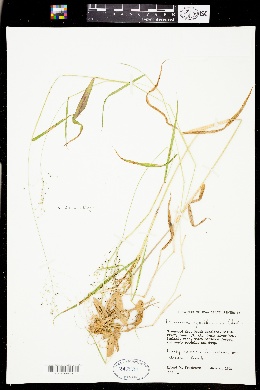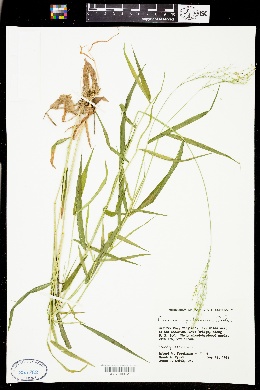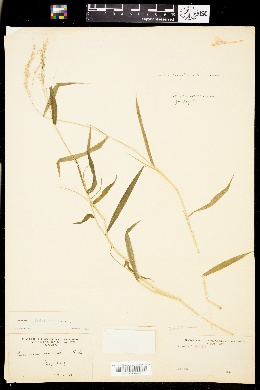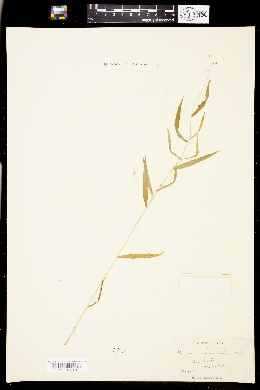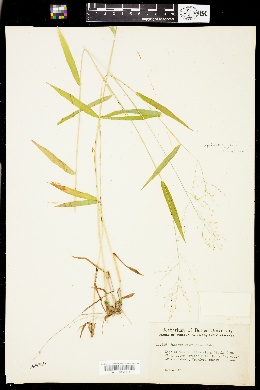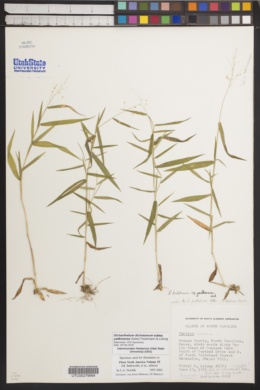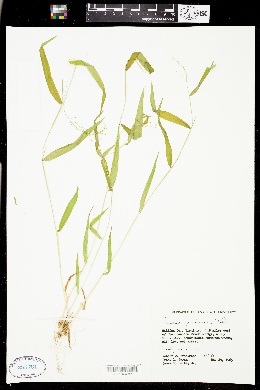Dichanthelium dichotomum subsp. yadkinense
|
|
|
|
Family: Poaceae
Cypress Witch Grass
|
Culms 50-100 cm; nodes usually glabrous; internodes usually glabrous, often yellowish-green; fall phase suberect, sparsely branched from the midculm nodes, blades not as greatly reduced as in the other subspecies. Cauline sheaths glabrous, often with pale glandular spots between the prominent veins; blades 9-14 cm long, 7-12 mm wide, thin, widest near the middle and tapering to both ends, glabrous on both surfaces. Spikelets 1.9-2.6 mm, elliptic to subfusiform, glabrous, apices acute or beaked. Upper florets 1.8-2 mm. 2n = 18. Dichanthelium dichotomum subsp. yadkinense grows in rich, moist or wet woods. A relatively uncommon subspecies, its range extends from Pennsylvania to Maryland and south through southern Illinois and southeastern Missouri to Georgia and Louisiana, but not to Florida. It exhibits traits of D. laxiflorum and D. commutatum. Perennial herb, tufted 0.5 - 1 m tall Inflorescence: a terminal, branched arrangement of spikelets (panicle). Primary panicles atop the culms, 3 - 12 cm long, long-exserted, wiry-branched. Secondary panicles (when present) atop the branches. Fruit: a caryopsis, indehiscent, enclosed within the persistent lemma and palea. Culm: decumbent to upright, 0.5 - 1 m long, round in cross-section, hollow, usually hairless. Fall phase nearly upright, sparsely branched from the mid-culm nodes, with leaf blades that are not as reduced as in the other subspecies. Spikelets: 2 - 2.5 mm long, ellipsoid to almost spindle-shaped with a pointed or beaked apex, prominently veined. Basal leaves: in a rosette. Blades shortly egg-shaped to lance-shaped, distinct from stem blades. Stem leaves: four to seven, alternate, two-ranked. Sheaths usually shorter than internodes, often gland-spotted between prominent veins. Ligules about 0.5 mm long, composed of hairs. Blades thin, distinctly longer and narrower than basal leaves, 9 - 14 cm long, 7 - 12 mm wide, lance-shaped with a tapering base and tapering tip (widest near middle), parallel-veined. Glumes:: Lower glumes usually less than one-third as long as spikelets, blunt to pointed. Upper glumes about as long as lower lemmas and upper florets, rounded to pointed at the apex. Lemmas:: Lower lemmas similar to upper glumes. Upper lemmas longitudinally lined, shiny, with rolled-up margins above. Paleas:: Lower paleas shorter than lower lemmas, thin. Upper paleas longitudinally lined. Florets:: Lower florets sterile. Upper florets bisexual, stalkless, about 2 mm long, less than 1 mm wide, ellipsoid with a blunt to nearly pointed apex, plump. Anthers three. Stigmas red. Similar species: No information at this time. Flowering: May to September Habitat and ecology: No information at this time. Occurence in the Chicago region: native Etymology: Dichanthelium comes from the Greek words di, meaning twice, and anth, meaning flowering, referring to plants that may have two flowering periods. Dichotomum means "forking in pairs." Yadkinense comes from "Yadkin River" (in North Carolina), although it was originally cited as from Raleigh in the Neuse valley. Author: The Morton Arboretum From Flora of Indiana (1940) by Charles C. Deam Infrequent in a few southern counties on the slopes and bases of wooded, usually high hills. ...... Indiana Coefficient of Conservatism: C = 8 Wetland Indicator Status: FAC |





















